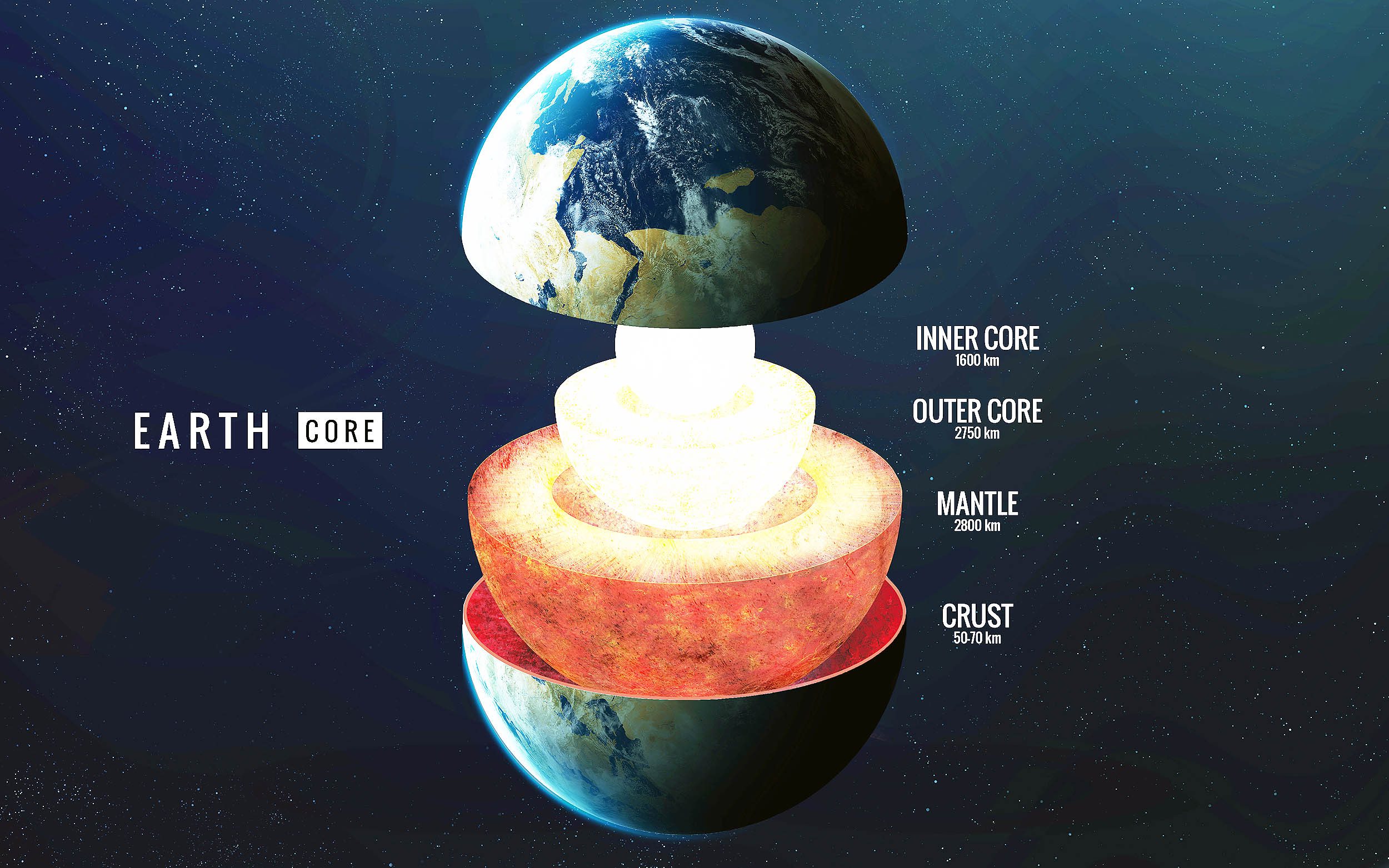
Buried beneath extensive layers of rock and molten metal, Earth’s inner core has traditionally been regarded as a solid sphere. However, a groundbreaking study indicates that the surface of the inner core is not static but is experiencing structural changes and shape alterations.
This discovery suggests that the center of our planet is much more active than previously thought, potentially reshaping our comprehension of Earth’s evolution, its magnetic field, and its rotational dynamics.
These insights not only expand our understanding of Earth’s inner workings but also provoke fascinating inquiries about the underlying forces at play beneath our feet.
The Fundamentals of Earth’s Interior
Think of Earth’s interior as a colossal layered cake, featuring four primary layers: the crust, mantle, outer core, and inner core.
The crust is the thin, outermost layer where human beings reside, characterized by large plates that are in constant motion. Below it lies the mantle, which plunges about 1,800 miles deep and comprises hot, semi-solid rock that flows gradually.
This movement is the driving force behind plate tectonics, leading to earthquakes, volcanic activity, and the formation of mountains over millions of years.
As depth increases, so do temperatures, with the mantle’s intensity reaching thousands of degrees.
Situated beneath the mantle, the outer core consists of molten iron and nickel, which circulates to create Earth’s protective magnetic field.
This invisible force acts as a shield against harmful solar radiation and ensures that compasses reliably point north. At the very heart of the planet, the inner core is a solid sphere composed of iron and nickel, with temperatures exceeding 9,000°F—hotter than the sun’s surface.
Despite the extreme heat, immense pressure keeps the inner core in a solid state. Since drilling to such depths is not feasible, scientists rely on seismic waves from earthquakes to gather insights about this mysterious region. This method was employed in the recent study.
Revisiting Our Understanding of Earth’s Inner Core
The inner core, located approximately 3,000 miles (4,800 kilometers) beneath the surface of the Earth, was once thought to be an unyielding sphere.
The researchers of the recent study were particularly focused on analyzing the rotation of the inner core and identifying its decelerating movements.
They aimed to decipher the reasons behind the inner core’s apparent rotation lagging behind Earth’s own rotation, which subsequently accelerated in 2010.
By scrutinizing decades of seismic data, they stumbled upon the unexpected result that the inner core’s surface is indeed changing shape.
Seismic Waves as Catalysts
During their analysis of various seismic waveforms, one specific set of data caught their attention due to its peculiar characteristics. This led the researchers to conclude that the Earth’s inner core is not entirely solid and possesses the ability to reshape itself.
The methodology employed was straightforward. The team examined seismic waveform data from numerous earthquakes occurring between 1991 and 2024 near the South Sandwich Islands of Antarctica.
This examination unveiled a dataset with unparalleled features, suggesting significant internal disturbances within the inner core.
The Dynamic Nature of the Inner Core
The extensive analysis of this data set revealed a dynamic process that had not been accounted for in previous geological models.
The findings indicated that the inner core is not static but is continually undergoing complex reshaping processes. This directly challenges the traditional view of the inner core’s long-term stability.

The research suggested that the inner core’s surface layer may experience viscous deformation, causing gradual and recurring alterations to its shape due to extreme pressures and interactions with the volatile outer core.
Interactions with the Outer Core
The research team observed that the interactions between the inner and outer core appear to be driving these transformations.
The turbulent nature of the molten outer core was previously not believed to disrupt the inner core within human timescales. However, it now appears that the outer core may be influencing the inner core by prompting deformation of its surface layer, opening new avenues to explore the dynamics hidden within Earth’s core.
Professor John Vidale, who spearheaded the study, believes that the inner core’s boundaries could have deformed over 100 meters in specific regions.
“While this finding may not directly impact our daily lives, understanding the processes occurring in the Earth’s center is crucial,” Professor Vidale remarked.
Broader Implications of the Findings
This revelation could significantly enhance our understanding of Earth’s thermal and magnetic fields. Additionally, it provides new insights into the complex interactions between the inner and outer core.
Researchers speculate that these changes may relate to fluctuations in Earth’s magnetic field.
“The magnetic field has experienced disturbances at various points within the last few decades, and we aim to determine if these are connected to the changes occurring at the inner core boundary,” said Professor Vidale.
A better grasp of these processes could refine our models regarding geomagnetic field generation, plate tectonics, and even Earth’s long-term climate stability.
Unanswered Questions Persist
This study not only questions prevailing geological models but also serves as a strong reminder that fundamental features of our planet are continually up for reevaluation.
The inner core, once regarded as unchanging and solid, now appears to be in a state of continuous motion, transforming and reshaping over time.
Yet, numerous questions linger. What regulates the rate of these changes? How might they affect broader geodynamic processes? Could similar phenomena occur in the cores of other celestial bodies?
As technology progresses and seismic data becomes increasingly precise, the inner workings of our planet will shift from being an unfathomable mystery to an accessible frontier ready for exploration.
The complete study was published in the journal Nature Geoscience.
—–
Enjoyed this article? Sign up for our newsletter to receive engaging articles, exclusive content, and the latest updates.
Check out EarthSnap, a free app developed by Eric Ralls and Earth.com.
—–









